Mini Transat: A Storm Brewing
Published on November 10th, 2017
(November 10, 2017; Day 9) – One could get a sense of it from looking at the Mini-Transat La Boulangère competitors’ trajectories. The trade wind, never totally steady at the best of times, has been ruffled by stormy squalls, which are causing significant variations in the wind, both in terms of strength and direction. Together with the fatigue, any errors in judgment or maneuvering can prove costly.
“Tell me about the rain not the fair weather, the fair weather disgusts me…” sang French singer-songwriter Georges Brassens, but it’s not certain that these particular lyrics would win much acclaim in this last third of the Atlantic. Indeed, the stormy squalls, which are beginning to set the tone, in addition to a need for increased vigilance, are likely to complete shake up the trade wind system, until it is virtually on its knees as the fleet approach the Antilles arc.
For now, the feedback from the support boats is indicating white squalls, still without any really striking cloud formations, but which may cause the wind to pick up violently to nearly thirty knots, whilst turning through 30 to 40 degrees. Naturally, in such conditions, there are sure to be a number of broaches as indicated by a significant lull in boat speed as the skipper takes the time to digest recent events.
Is this what has happened to Elodie Pédron? The skipper of Manu Poki et les Biotechs has just spent several hours with the boat at a virtual standstill, clearly the victim of some sort of technical issue, which was sufficiently crippling that her friend Marta Güemes (Artelia) diverted course in a bid to sail alongside her.
Since that time, Elodie has begun making headway again, albeit at a reduced speed. A support boat should be heading over to her tonight to find out more, but it’s not an impossible scenario that her mission to jury rig the rudders before the Cape Verde islands has given up the ghost.
At the head of the race, Ian Lipinski (Griffon.fr) will be able to begin to feel like he has the race in the bag now. Indeed, some 150 miles ahead of his rivals and less than 1,000 miles from the finish, he’s starting to boast a comfortable lead.
However, it’s a close race for second place between Simon Koster (Eight Cube Sersa) and Jörg Riechers (Lilienthal), who are just a tenth of a mile apart in terms of the distance to the goal. Will Jörg be paid for his audacity after choosing a radical southerly option? The outcome will be seen in twenty-four hours’ time.
Another sailor with plenty of pluck is Tanguy Bouroullec (Kerhis Cerfrance), who has amassed nearly 300 miles of lateral separation to the south of the chasing pack and over 400 in relation to the inseparable top two, Erwan Le Draoulec (Emile Henry) and Clarisse Crémer (TBS). In fact, it’s the first time since negotiating the Cape Verde islands that the routes of the two leaders have diverged. Consequently, anything is possible.
In 2015, Ian Lipinski and Julien Pulvé sailed in convoy up to five days from the finish at which point the sailor from La Rochelle managed to slip away. Ultimately, Julien won the leg by a comfortable margin, causing the announced victory of Ian Lipinski to wobble. Given the conditions that the solo sailors are set to encounter in the coming days, the craziest scenarios could become a reality.
Among the production boats, there is so little separating them that nobody would be so bold as to call a winner. It’s an important psychological boost to see a three-figure distance being displayed on the GPS. However, it would perhaps be better to cast such thoughts to one side for now, especially given the weather conditions expected. Thinking about it, Brassens has some funny ideas at times.
Position report on 10 November at 15:00 UTC
Prototypes
1 Ian Lipinski (Griffon.fr) 794.4 miles from the finish
2 Simon Koster (Eight Cube Sersa) 149.7 miles behind the leader
3 Jorg Riechers (Lilienthal) 149.8 miles behind the leader
4 Andrea Fornaro (Sideral) 223.6 miles behind the leader
5 Kéni Piperol (Région Guadeloupe) 257.7 miles behind the leader
Production boats
1 Erwan Le Draoulec (Emile Henry) 1,035.3 miles from the finish
2 Clarisse Crémer (TBS) 51.3 miles behind the leader
3 Tom Dolan (offshoresailing.fr) 94.1 miles behind the leader
4 Benoît Sineau (Cachaça 2) 107.5 miles behind the leader
5 Pierre Chedeville (Blue Orange Games – Fair Retail) 131.5 miles behind the leader
Class news – Race news – Tracking – Facebook
Race Facts
· 21st edition
· 4,050 miles to cover between La Rochelle – Las Palmas in Gran Canaria and Le Marin (Martinique)
· 81 skippers at the start
· 10 women
· 11 nationalities
· 20 years: age of the youngest skipper in the race: Erwan Le Draoulec
· 62 years: age of the oldest skipper in the race: Fred Guérin
· 25 prototypes
· 56 production boats
· 66 rookies
· 15 ‘repeat offenders’
Background
With an overall length of 6.50m and a sail area pushed to the extreme at times, the Mini Class offers incredibly seaworthy boats. Subjected to rather draconian righting tests and equipped with reserve buoyancy making them unsinkable, the boats are capable of posting amazing performances in downwind conditions… most often to the detriment of comfort, which is rudimentary to say the least.
The Mini Transat has two legs to carry the fleet from La Rochelle, France to Martinique, West Indies. The leg from La Rochelle to Las Palmas de Gran Canaria is a perfect introduction to proceedings before taking the big transatlantic leap.
The first leg starts on October 1, with the fleet thrust into the Bay of Biscay which can be tricky to negotiate in autumn, while the dreaded rounding of Cape Finisterre on the north-west tip of Spain marks a kind of prequel to the descent along the coast of Portugal. Statistically, this section involves downwind conditions, often coloured by strong winds and heavy seas. Making landfall in the Canaries requires finesse and highly developed strategic know-how.
The second leg begins on November 1, with the solo sailors most often carried along by the trade wind in what tends to be a little over two weeks at sea on average. Due to a storm, the fleet is being routed south to Cape Verde before heading west. At this point, there’s no way out: en route to the West Indies, there are no ports of call. The sailors have to rely entirely upon themselves to make Martinique.
Source: Aurélie BARGAT | Effets Mer


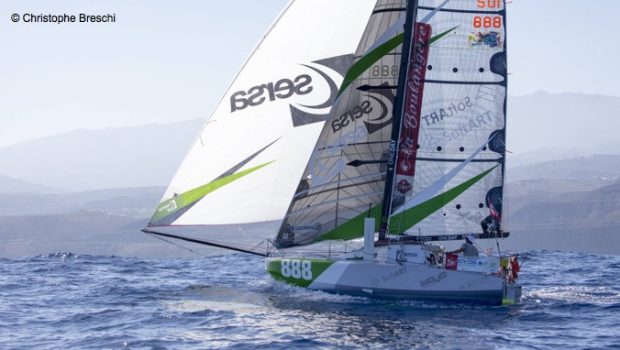

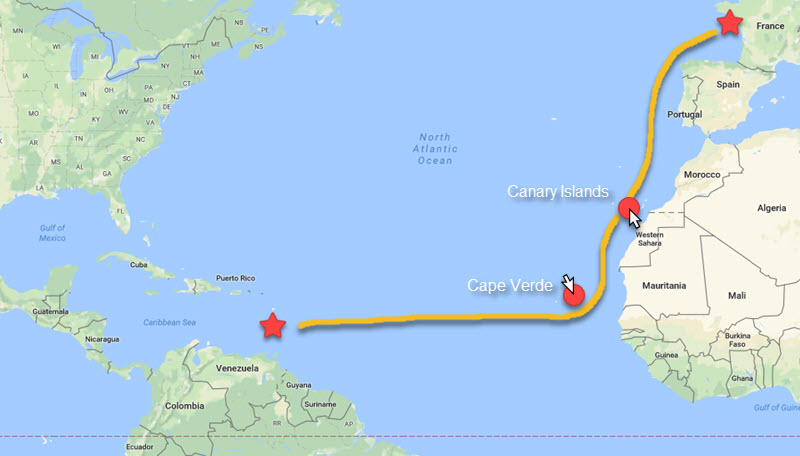


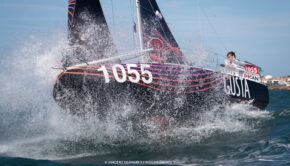
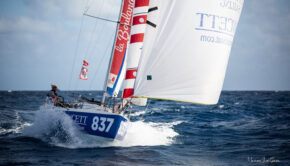
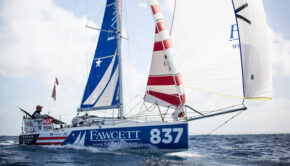
 We’ll keep your information safe.
We’ll keep your information safe.